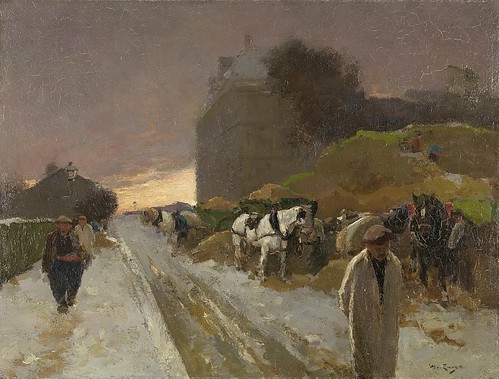Jan Steen arranges the various actors as though on a theatre stage. The gentle depth of the composition is based on a triangle, with the magnificently dressed young woman at its top point. Her clothing and seductive look identify her as a loose-living girl. She, however, is not the focus of the scene; that is provided by the lady of the house, who has fallen asleep at the table on the left. Her absence has resulted in the rest of the story: the dog is finishing the meat pie that was served on the table, one of the children is filching something from the cabinet on the wall, the little girl’s brother is trying out a pipe, and the youngest child, sitting in his highchair, is playing carelessly with a string of pearls. His attention diverted to the side, a young man is trying to play a violin.
Young people who continued to live at home were considered suspect in the popular culture of the Netherlands at the time. The prostitute in the foreground has already been mentioned: in a provocative gesture she holds a filled glass between the legs of the man of the house, while he dismisses with a grin the admonishment of the nun standing on the right. The duck on the shoulder of the man next to her identifies him as a Quaker, who urges the reading of pious texts. Hanging above the heads of these sinners are the symbols of the penalty to be expected for unbridled, lustful behaviour: a sword and a crutch in a basket suspended from the ceiling.
[Kunsthistorishes Museum, Vienna - Oil on canvas, 145.5 x 105 cm]
![Johan Barthold Jongkind - The Boulevard de Port-Royal, Paris [1877] by Gandalf's Gallery](http://farm9.staticflickr.com/8046/8130297459_ecaef4b542.jpg)
![Camille Corot - The House and Factory of Monsieur Henry [1833] by Gandalf's Gallery](http://farm9.staticflickr.com/8330/8130322452_9ca5051a98.jpg)
![Léon-Augustin Lhermitte - Apple Market, Landerneau, Brittany [c.1878] by Gandalf's Gallery](http://farm9.staticflickr.com/8463/8127034969_defd689716.jpg)
![Léon-Augustin Lhermitte - The Gleaners [1887] by Gandalf's Gallery](http://farm9.staticflickr.com/8189/8127061354_41e4e2ede0.jpg)
![Edgar Degas - Interior [c.1868] by Gandalf's Gallery](http://farm9.staticflickr.com/8050/8124292799_235485fcab.jpg)
![Jean-François Raffaëlli - Artist Painting [c.1879] by Gandalf's Gallery](http://farm9.staticflickr.com/8475/8124292563_f49478920e.jpg)
![Jan Steen - Rhetoricians at a Window [c.1661-66] by Gandalf's Gallery](http://farm9.staticflickr.com/8043/8121446363_c901028259.jpg)
![Jan Steen - As the Old Ones Sing, So the Young Ones Pipe [c.1670-75] by Gandalf's Gallery](http://farm9.staticflickr.com/8471/8121461696_8379cbc579.jpg)
![Johannes Vermeer - Woman in Blue Reading a Letter [1663-64] by Gandalf's Gallery](http://farm9.staticflickr.com/8045/8118561898_357429517f.jpg)
![Johannes Vermeer - Woman in Blue Reading a Letter [1663-64] by Gandalf's Gallery](http://farm9.staticflickr.com/8463/8118548361_aefe940f48.jpg)
![Mary Cassatt - In the Loge [c.1879] by Gandalf's Gallery](http://farm9.staticflickr.com/8334/8115445867_f91ce8e6a2.jpg)
![Mary Cassatt - Woman with a Pearl Necklace in a Loge [1879] by Gandalf's Gallery](http://farm9.staticflickr.com/8323/8115445655_01bf078b61.jpg)
![Claude Monet - Lavacourt Under Snow [c.1878-81] by Gandalf's Gallery](http://farm9.staticflickr.com/8045/8111996439_ebe7401d15.jpg)
![Claude Monet - Green Park, London [1870 or 1871] by Gandalf's Gallery](http://farm9.staticflickr.com/8476/8111994889_ef797b4050.jpg)
![Pierre Puvis de Chavannes - War [1867] by Gandalf's Gallery](http://farm9.staticflickr.com/8323/8107972943_ab03ae15ee.jpg)
![Pierre Puvis de Chavannes - Peace [1867] by Gandalf's Gallery](http://farm9.staticflickr.com/8475/8107982988_fbeabffd5f.jpg)
![Henry Oliver Walker - A Morning Vision [1895] by Gandalf's Gallery](http://farm9.staticflickr.com/8047/8104825914_537b55426d.jpg)
![Pierre-Auguste Renoir - The Great Bathers [1884-87] by Gandalf's Gallery](http://farm9.staticflickr.com/8326/8104812213_44708b8cde.jpg)

![Johannes Lingelbach - The Camp [1650-74] by Gandalf's Gallery](http://farm9.staticflickr.com/8047/8102114384_86bb8d8149.jpg)
![Hendrick Goltzius - Lot and His Daughters [1616] by Gandalf's Gallery](http://farm9.staticflickr.com/8476/8099339872_af2022c033.jpg)
![Hendrick Goltzius - Vertumnus and Pomona [1613] by Gandalf's Gallery](http://farm9.staticflickr.com/8325/8099339656_0a206824be.jpg)
![Thomas Couture - The Thorny Path [1873] by Gandalf's Gallery](http://farm9.staticflickr.com/8327/8096294551_ed3f9853bb.jpg)
![Joseph Mallord William Turner - The Sun Rising Through Vapour [before 1807] by Gandalf's Gallery](http://farm9.staticflickr.com/8055/8096301644_592f1faab0.jpg)
![Gustave Courbet - The Young Bather [1866] by Gandalf's Gallery](http://farm9.staticflickr.com/8473/8093132012_f688f8143d.jpg)
![Unknown French Artist - Study of a Nude Man [c.1816] by Gandalf's Gallery](http://farm9.staticflickr.com/8044/8093126781_8e0a1286a2.jpg)
![Georges Seurat - Circus Sideshow [1887-88] by Gandalf's Gallery](http://farm9.staticflickr.com/8044/8089600101_75c27bf62f.jpg)
![Camille Pissarro - L’Île Lacroix, Rouen (The Effect of Fog) [1888] by Gandalf's Gallery](http://farm9.staticflickr.com/8194/8089600241_3c6cb2392e.jpg)
![Ludolf Bakhuysen - Ships in Distress of a Rocky Coast [1667] by Gandalf's Gallery](http://farm9.staticflickr.com/8464/8085497271_682d269706.jpg)
![Ludolf Bakhuysen - Ships in Distress in a Heavy Storm [c.1690] by Gandalf's Gallery](http://farm9.staticflickr.com/8045/8085495394_bc9f943059.jpg)
![Jan Steen - Beware of Luxury [1663] by Gandalf's Gallery](http://farm9.staticflickr.com/8188/8082133560_3588d5b711.jpg)
![Jan Vermeer - The Art of Painting [1666-68] by Gandalf's Gallery](http://farm9.staticflickr.com/8184/8082134264_0175e00625.jpg)
![Gerard van Honthorst - Flute Playing Shepherd and Four Nymphs [1632] by Gandalf's Gallery](http://farm9.staticflickr.com/8049/8079226116_4fb537a601.jpg)
![Antonio da Vendri - The Giusti Family of Verona [c.1520] by Gandalf's Gallery](http://farm9.staticflickr.com/8473/8079226804_fec42e4345.jpg)
![Jean-Léon Gérôme - Pygmalion and Galatea [c.1890] by Gandalf's Gallery](http://farm9.staticflickr.com/8051/8076376348_ac188244ec.jpg)
![Jean-Léon Gérôme - Prayer in the Mosque [1871] by Gandalf's Gallery](http://farm9.staticflickr.com/8466/8076376134_34ebe4ecf2.jpg)
![Thomas Eakins - A May Morning in the Park (The Fairman Rogers Four-in-Hand) [1879-80] by Gandalf's Gallery](http://farm9.staticflickr.com/8036/8073403324_cd283535c5.jpg)
![Winslow Homer - Snap the Whip [1872] by Gandalf's Gallery](http://farm9.staticflickr.com/8031/8073410257_fcc83d774b.jpg)
![Gerard van Honthorst - A Cheerful Violin Player [1623] by Gandalf's Gallery](http://farm9.staticflickr.com/8316/8070008313_55e85728fb.jpg)
![Willem Duyster - Soldiers Beside a Fireplace [c.1628-32] by Gandalf's Gallery](http://farm9.staticflickr.com/8174/8070008107_a84a7e20ab.jpg)
![Auguste Renoir - Reclining Nude [1883] by Gandalf's Gallery](http://farm9.staticflickr.com/8177/8066153079_570f757285.jpg)
![Pierre Puvis de Chavannes - The Prodigal Son [c.1879] by Gandalf's Gallery](http://farm9.staticflickr.com/8322/8066154238_84043952eb.jpg)
![Louis Gallait - Peace [1872] by Gandalf's Gallery](http://farm9.staticflickr.com/8322/8062138570_82b994478e.jpg)
![Louis Gallait - War [1872] by Gandalf's Gallery](http://farm9.staticflickr.com/8455/8062138244_69dcef50ac.jpg)
![William Stanley Haseltine - Santa Maria della Salute, Sunset [1870-85] by Gandalf's Gallery](http://farm9.staticflickr.com/8042/8059409124_0eb6038a0a.jpg)
![Adolphe-Félix Cais - The Farm at Saint Simon, Honfleur [1876] by Gandalf's Gallery](http://farm9.staticflickr.com/8458/8059409542_88e3747cba.jpg)
![Claude Monet - Houses of Parliament (Effect of Fog) [1903-04] by Gandalf's Gallery](http://farm9.staticflickr.com/8462/8055982459_e2cb33dde2.jpg)
![Claude Monet - Haystacks (Effect of Snow and Sun) [1891] by Gandalf's Gallery](http://farm9.staticflickr.com/8180/8055982897_a2c9c7b49a.jpg)
![Jacob Duck - Interior with Soldiers and Women [c.1650] by Gandalf's Gallery](http://farm9.staticflickr.com/8173/8053069017_fd4f9af909.jpg)
![Eastman Johnson - The Hatch Family [1870-71] by Gandalf's Gallery](http://farm9.staticflickr.com/8316/8053076358_ab0e8c0426.jpg)